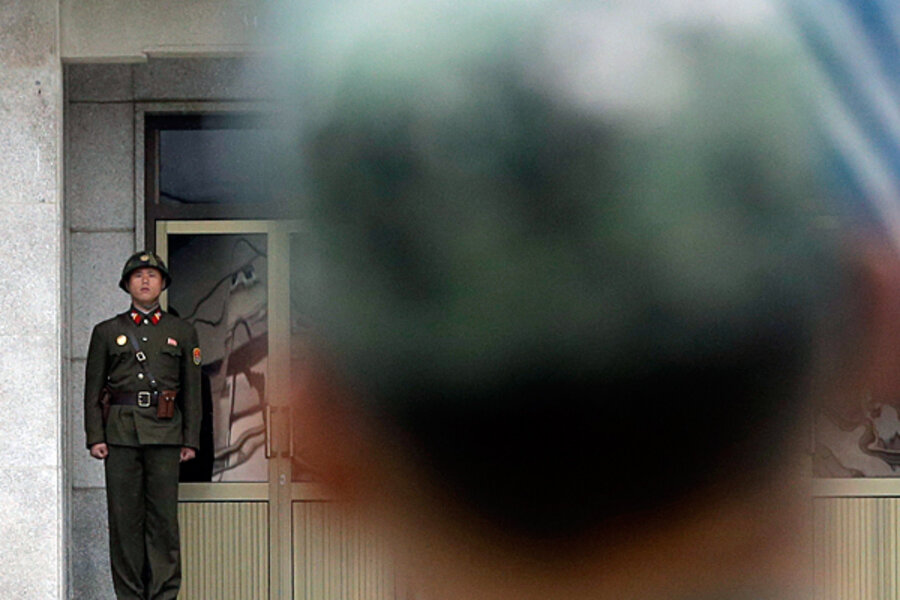North Korea threat: Is it cooling?
Loading...
| Seoul, South Korea
North Korea picked Wednesday April 10 as the day by which foreign embassies in Pyongyang should submit evacuation plans, foreigners should leave South Korea, and South Korean workers should leave the now barely functioning Kaesong Industrial Complex, hinting at a provocation that could bring the area into a state of conflict.
Though North Korea has threatened South Korea many times in the past, this time analysts are viewing the situation differently, seriously considering the possibility of a large-scale provocation from the North. North Korea is believed to have moved two Musudan missiles to its eastern coast last week, leading many to predict an imminent missile launch. South Korean and US defense forces responded by upgrading their military surveillance postures looking for signs of a North Korean rocket launch.
But as the day came and went with no observed action, it raised the question: Have North Korea’s heated rhetoric and threats been bluffs?
“The general principle is to escalate tensions in order to later be able to negotiate from a position of strength,” says Leonid Petrov, a researcher in Korean studies at Australian National University.
Musudan missiles have a range of about 1,875 miles, meaning they could reach anywhere in South Korea, Japan, or the US territory of Guam.
But as the Musudan missiles have never been flight-tested by North Korea, their launch might be unlikely, as the North would be wary of the loss of face that would come with an unsuccessful launch attempt.
According to analysts, the raising of tensions may be a deliberate ploy to create an atmosphere of nervousness about North Korea’s next move and thereby strengthen Pyongyang’s hand when it comes time to negotiate next with the international community.
North Korea, for example, raised eyebrows with seemingly irrational acts like pulling workers out of the joint North-South Kaesong industrial park, an important source of revenue for the cash-strapped country. According to Mr. Petrov, this type of short-term move could pay off down the road when North Korea seeks aid or economic assistance. Hostile rhetoric can also contribute to more important ends like rallying citizens around an ideology of confrontation with enemies, particularly the US and South Korea.
“North Korea’s leadership is willing to do things that may be self-harming in the short term. Money is not the most important thing to them. Things like maintaining their system, the stability of the leadership, the isolation of the people from other sources of information, those are the most critical things,” says Petrov.
In a New York Times opinion piece on Tuesday, Kookmin University professor Andrei Lankov wrote, “Put bluntly, North Korea’s government hopes to squeeze more aid from the outside world. Of late, it has become very dependent on Chinese aid, and it wants other sponsors as well.”
Today in Seoul, the US Department of State reiterated its position that there was no reason for US citizens to expect any special danger in South Korea, in a statement that read, “North Korea’s reported 'advice' to foreigners that they depart South Korea only serves to unnecessarily and provocatively escalate tensions."
Still, South Korean Foreign Minister Yun Byung-se told a parliamentary hearing today, "according to intelligence obtained by our side and the US, the possibility of a missile launch by North Korea is very high." Mr. Yun added that a missile launch could still come “at any time.”
South Korea’s police raised their state of terror alert one level from “attention” to “caution” out of concern for a possible North Korean terrorist attack.
Dates and numbers have great symbolic importance to North Korea, so Pyongyang often schedules what Washington calls "provocative acts" around holidays and important political events. Some are eyeing the anniversary of the birthday of Kim Il-sung, the state's founder and the current leader's grandfather, on April 15.
Also on Wednesday, the South Korean government announced that it had determined that North Korea was behind cyberattacks that disrupted the systems of several banks and broadcasters on March 20. This has fed speculation that North Korea will increasingly use asymmetric tactics that are still harmful but avoid direct military conflict, where it is at a significant disadvantage.








